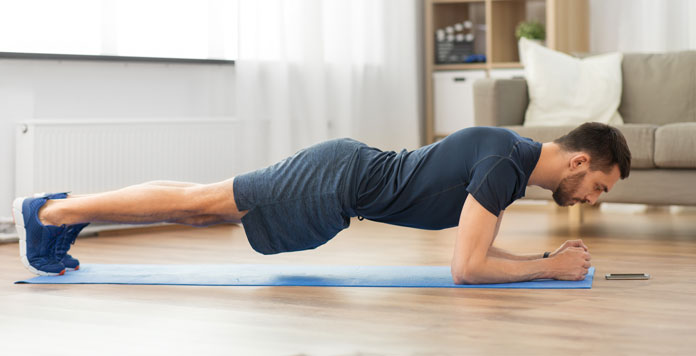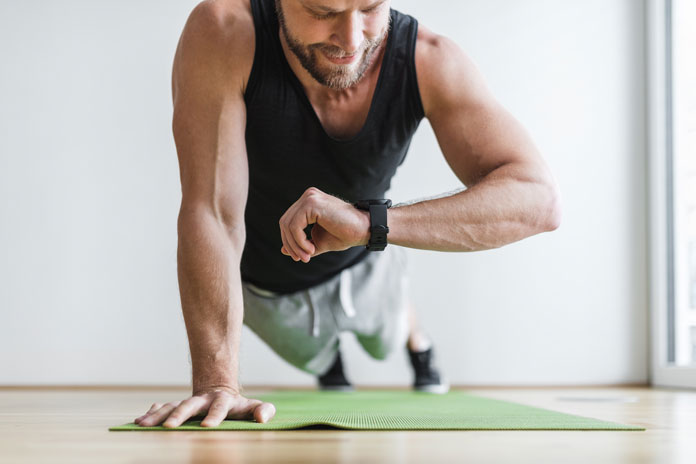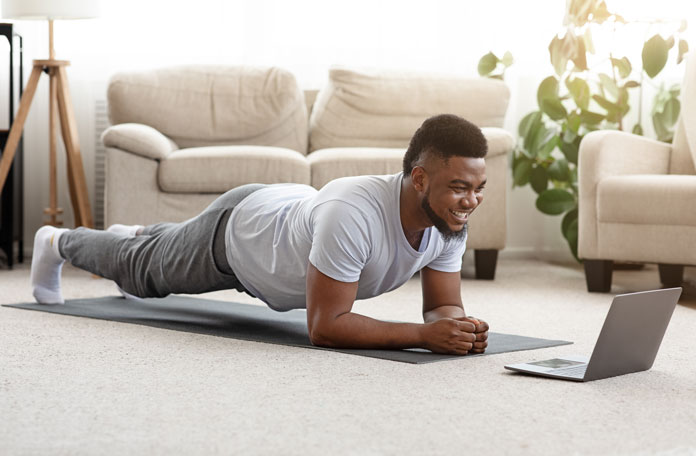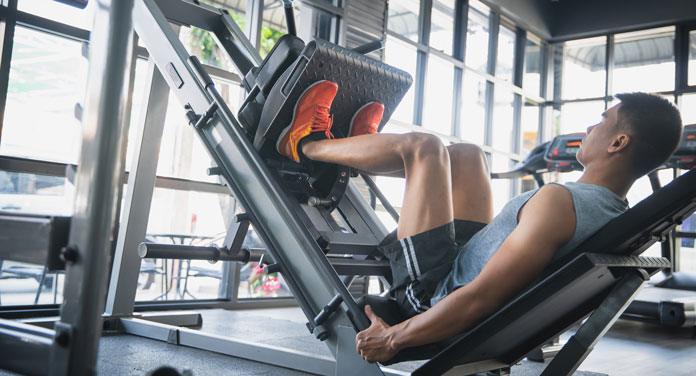Isometric training is much more than just a modern fitness trend: With the help of this form of training, muscles can be built up effectively and posture can be permanently improved.
In conventional strength and endurance training, muscle stimuli are set through dynamic movements. In isometric training, on the other hand, it is important to hold a static position for as long as possible. So you train your muscles without moving. But how exactly can this work? We want to deal with this in detail in this article.
What Is The Thinking Behind Isometric Training?

Training without moving doesn’t sound very demanding at first. However, this assumption is grossly misleading. Static exercises often require even more effort than dynamic exercises. Do you take a strenuous position such as B. a plank, constant pressure is exerted on your entire musculature? This is called an isometric contraction.
If you try it once, you will realize how much effort it takes. You now try to hold the static position as long as possible. It is best to use a stopwatch to check the time.
Static holding also addresses deep-seated muscle groups that you cannot reach with conventional fitness exercises. If you repeat the isometric exercises regularly, you will find that you gradually become considerably stronger. This means you can hold your static position longer and longer. Your body tension will also improve.
What Does It Take To Start Isometric Training?
The beauty of isometric training is that it doesn’t require any equipment. You can start at any time from home. Later we will introduce you to the most effective exercises. Since there are no accessories to purchase and no gym membership required, there are of course no excuses.
Who Is This Type Of Training Suitable For?

Isometric training is suitable for almost everyone. Both beginners and advanced athletes can benefit from doing static exercises regularly. In the meantime, entire movements of athletes have come together in the fitness scene who fully rely on the advantages of isometric training. Since most of these athletes have strong physiques, they’re living proof that isometric training works.
Many athletes use isometric training as a useful addition to their usual strength training with equipment. Through static exercises z. B. improves grip strength, which means that the athlete can do more pull-ups. Overall, the performance can be increased. Since the muscles no longer tire as quickly, the risk of injury is also reduced.
Can All Muscle Groups Be Trained?
Clearly yes. Isometric training is a full-body workout. In order to hold a static position for any length of time, all the muscles in the body must be in tension. The abdomen, lower back, and trunk muscles can be strengthened particularly effectively. The arm and leg muscles are also effectively used in most static exercises.
How Does Isometric Training Improve Body Stability?
Strong muscles ensure an upright posture and stability. The trunk muscles in particular contribute to a healthy posture. Below we would like to introduce you to a few static exercises that you can use to specifically strengthen your core muscles.
1. The Ultimate Classic: The Plank

Nobody who deals with isometric training can avoid the plank. The plank is also an optimal exercise for more body stability, as it challenges the entire trunk musculature. Nice side effect: The abdomen and shoulder girdle are also trained statically, provided you do the exercise correctly.
That’s how it works:
You support yourself on your forearms and lift your knees off the floor. You should now be standing on your tiptoes. The body should be straight and form a line. You can only do this if you tense all your muscles. Be careful not to accidentally slouch. To be on the safe side, do the exercise in front of a mirror so that you can correct your posture immediately. Try to hold the position for thirty seconds. Do at least three reps with a short fifteen-second rest between sets.
2. Knee/Forearm Plank
This exercise is extremely effective because, in addition to the entire trunk musculature, the hip and thigh muscles, as well as the oblique abdominal muscles, are also addressed.
That’s how it works:
You lie on your side and support yourself on one knee and one forearm. It doesn’t matter if you start on the right or left side, as the sides will switch anyway in the second set. Stretch out your top leg and bend your bottom leg. Make sure your elbow is under your shoulder. Now push yourself off the floor by lifting your pelvis. Extend the upper leg until your upper body and your leg are at the same height. With your leg stretched out, do small push movements for about 20 to 30 seconds. The rest of your body remains absolutely stable throughout the exercise. Then you switch sides.
3. Side Plank

The previous exercises have primarily addressed the core muscles. The side plank, on the other hand, challenges the lateral trunk muscles and also strengthens the oblique abdominal muscles.
That’s how it works:
You support yourself in a lateral position on your forearm. Which side you want to start with is up to you. Make sure your elbow is under your shoulder. You put your feet on top of each other. Now push your pelvis off the floor until your body is in a straight line. You should hold this position for at least 20 seconds in the beginning. Try increasing the duration to 30 seconds (or more) later. Caution: Your forearm or shoulders may start to hurt. When this happens, check your posture. Do three repetitions per side.
4. The Hip Roller
This exercise is particularly good for training the lower back. The latter tends to cause problems if you don’t move enough in everyday life. The back extensor and the abdominal muscles are also trained during the hip roller exercise.
That’s how it works:
First, lie on your back and stretch your arms out to the sides of your body. Make sure that you only perform the following exercise so far that your shoulder blades remain in constant contact with the ground. Now stretch your legs straight up. Then let your legs slide to the side. Important: As soon as your shoulder blades lose contact with the ground, the position is no longer correct. Now hold this static exercise for at least fifteen seconds until you come back to the center and then slide your legs in the other direction. Again, hold the position for at least fifteen seconds. Do at least three passes per side.
5. Two Point Support
This extremely demanding exercise not only trains your torso, leg, buttocks, and shoulder muscles but also your sense of balance. Did you know that when you try to keep your balance, you automatically have to tense all your muscles? The two-point plank is an all-around effective exercise.
That’s how it works:
First, you get into a normal push-up position. Spread your arms and legs about shoulder-width apart. Now you lift your left leg and stretch your right arm upwards. At this point, it may feel a little wobbly. Balance yourself again. The head should be an extension of your cervical spine. So avoid craning your head or letting it droop. Your hips should remain in as straight a position as possible. Hold this static for about thirty seconds, then switch sides.
What Do You Have To Consider When Doing Isometric Training?
Since holding exercises are extremely challenging for the body, many athletes tend to hold their breath before exerting themselves. However, this is extremely counterproductive. Especially with isometric training, it is important to consciously pay attention to a flowing, regular breath. If you fail to do this, your blood pressure can rise excessively. High blood pressure can in turn lead to serious complications such as a heart attack or stroke. Especially if you already suffer from high blood pressure, you should focus on your breath during isometric training.
It is also important to take sufficient breaks from training. Isometric training can only fully develop its muscle-strengthening effect if you allow your body a sufficiently long regeneration time. You’ve probably heard it many times: During training, only the necessary stimuli are set, and muscle growth takes place in the resting phase. Specifically, this means that you should only do isometric training every two to three days. Static training not only puts a strain on your muscles, but your tendons, ligaments, and joints are also pushed to the limits of their resilience. For this very reason, the rest period is even more important than conventional strength training.
How Do You Achieve Ambitious Goals?

When you start isometric training, you may have a themed goal in mind, such as B. Finger push-ups or finger pull-ups. This goal can certainly be achieved with static training. However, you should not overdo it and allow yourself at least a year for such projects. Otherwise, there is a risk of injuries that will prevent you from doing your sport for a longer period of time.
What Other Health Benefits Does Isometric Training Offer?
You may think that just holding an exercise statically can get pretty boring over time. Try looking at it from a different perspective: Isometric training also calms your psyche. Just a few minutes in the plank or side plank can clear your head and give you a more neutral view of your job or relationship problems. Admittedly, it’s not for everyone to find peace of mind with isometric training. After all, isometric training is not yoga. If you actually get bored while doing the exercise, turn on the TV or listen to music during your workout.
By the way, isometric strength training can also be useful in your everyday life. If you have a job that requires you to sit in front of a computer for long hours, you may be a candidate for back and neck pain. With isometric training, you can specifically prevent such complaints. Your posture will also improve, which will automatically give you greater self-confidence. Those who stand and walk upright also appear larger, stronger, and more masculine to those around them. In addition, isometric strength training can strengthen your willpower, because this is exactly what is needed for holding exercises. So you see, it pays off to integrate isometric training into your everyday sporting life.
Which Isometric Exercises Are The Best?

There are a variety of isometric exercises. Below we would like to introduce you to a small selection that can be carried out by both beginners and advanced users.
Isometric Exercises For Arms And Chest:
Beginners simply press the palms together firmly in front of the chest and hold this position for at least 30 seconds. With this simple exercise, you can effectively train your chest muscles and biceps.
If you’re a regular at the gym, try the static bench press next time. This will really get your arm and chest muscles burning! To do this, lie down on the weight bench as usual and push the barbell up. Then lower your arms back down until your upper arms are horizontal to the floor. Hold this position for as long as you can.
Isometric Exercises For Legs And Buttocks
There is a very simple exercise for strong legs: wall sitting. To do this, lean against a wall and lower yourself until your knees are at an angle of about ninety degrees. So you’re practically sitting on a chair, just without the latter. You place your hands on your hips. But be careful, don’t cheat! You shouldn’t brace yourself. Hold this position for as long as possible. You’ll find that your hamstrings and glutes are pretty strained afterward.
Isometric Exercises For The Core And Back
We have already described various core exercises. This includes above all the plank in all its variations. The so-called shoulder bridge is specifically designed to strengthen the back. You start this exercise lying on your back. Raise your pelvis until only your shoulder blades touch the floor. This exercise is very beneficial, especially for the lower back.
Isometric Exercises For The Abdomen
The plank is also the perfect exercise to turn your abs into a six-pack. In the classic forearm support, you tense your straight abdominal muscles, which trains them better than all sit-ups. If you like, then briefly release one hand from the floor during the plank and feel your abdominal muscles. You will be amazed at how hard and tense they are. All side support exercises are suitable for stimulating the lateral abdominal muscles.
Isometric Exercises For Grip Strength
A good grip is also extremely practical in everyday life. Or do you want to embarrass yourself the next time your girlfriend asks you to open a pickle or jam jar? Probably not. To improve your grip strength, simply statically hang from a pull-up bar and hold out for as long as possible. If you don’t go to the gym, a sturdy branch will serve the same purpose.
Isometric Full Body Exercises
As an isometric full-body exercise, our plank should be mentioned again at this point. As you can see, this exercise is a true all-rounder. People who are particularly athletic can also do a headstand and hold it for a while. This requires a high level of body tension, which trains all muscles.
How Can You Get The Most Out Of Isometric Training?

Isometric training can help you improve your overall strength scores. Is there a dynamic exercise that you just can’t progress on? Everyone has their individual weaknesses. To overcome this, it can help to first perform the problematic exercise statically. Let’s say you’re stuck on the bench press. In this case, you should hold the weight statically several times as described above. If you succeed, you will be able to do the exercise dynamically without any problems after a while.
Conclusion: Isometric Training
Isometric training is suitable for everyone and can be wonderfully integrated into your training plan and everyday life. You don’t need any previous knowledge or equipment. With the help of this form of training, you can work on your weaknesses or increase your overall strength values.
There are no disadvantages to name, as long as you pay attention to the careful execution of the exercises. Isometric training > is often completely wrongly underestimated. However, it is definitely worth trying out. You will be amazed by the results.





